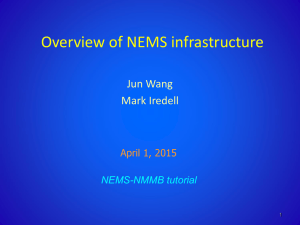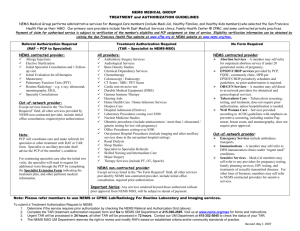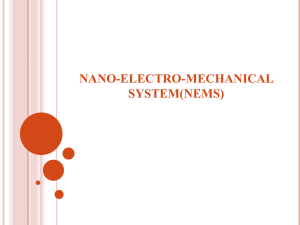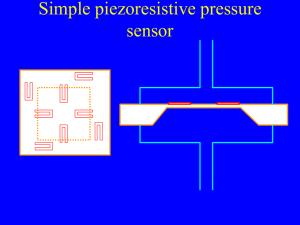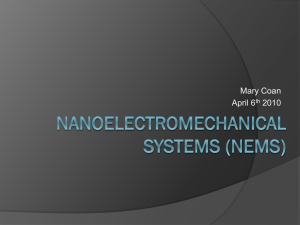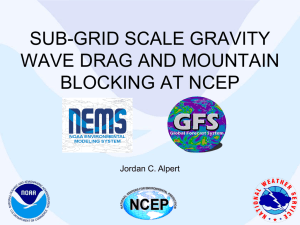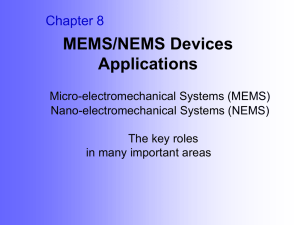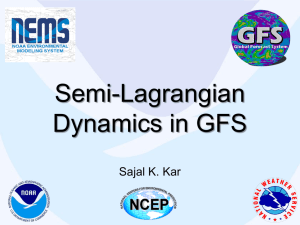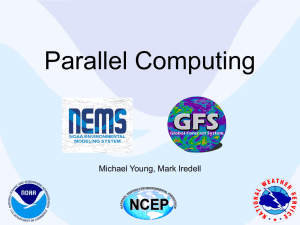Introduction to nanoelectromechanical systems (NEMS)
advertisement
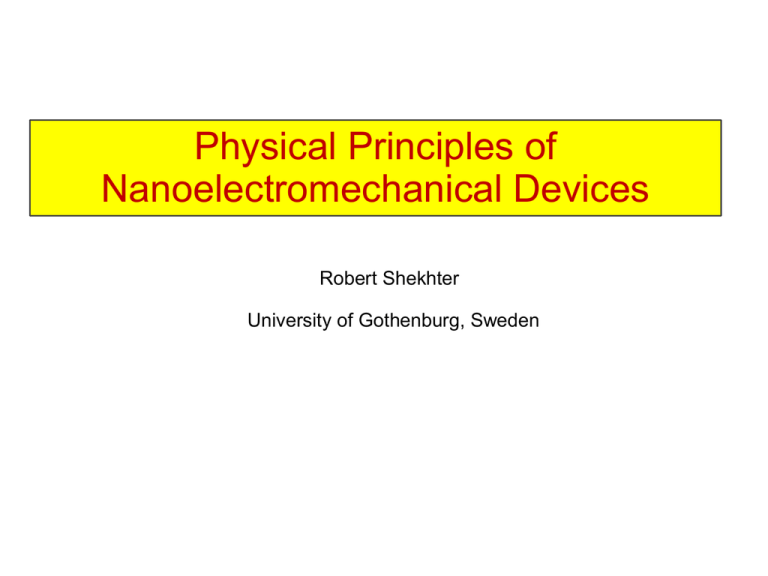
Physical Principles of Nanoelectromechanical Devices Robert Shekhter University of Gothenburg, Sweden Lecture 1: Introduction to nanoelectromechanical systems (NEMS) 2/35 Electromechanics and Charge Metrology William Gilbert Born on May 24, 1544, in Colchester, England Died on Dec. 10, 1603, in London The electroscope was an early scientific instrument used to detect the presence and magnitude of electric charge on a body. Lecture 1: Introduction to nanoelectromechanical systems (NEMS) 3/35 Downsizing of Electro-Mechanical Devices Macroscopic Electromechanical Device Micro-Electromechanical Accelerometer (Airbag Sensor) A small integrated circuit with integrated micro mechanical elements, which move in response to rapid deceleration. This motion causes a change in capacitance, which is detected by the electronics on the chip that then sends a signal to fire the airbag. Nano-Electromechanical Machinery in the Living Cell Ion channels make it possible for cells to generate and transmit electrical signals, and are the basic molecular building blocks in the nervous system. Rapid transport, ion selectivity, and electrically controlled channel gating are central to their functionality. Five-Lecture Course on the Basic Physics of Nanoelectromechanical Devices • Lecture 1: Introduction to nanoelectromechanical systems (NEMS) • Lecture 2: Electronics and mechanics on the nanometer scale • Lecture 3: Mechanically assisted single-electronics • Lecture 4: Quantum nano-electro-mechanics • Lecture 5: Superconducting NEM devices References Book: Andrew N. Cleland, Foundation of Nanomechanics Springer,2003 (Chapter7,esp.7.1.4, Chapter 8,9); Reviews: R.Shekhter et al. Low.Tepmp.Phys. 35, 662 (2009); J.Phys. Cond.Mat. 15, R 441 (2003) J. Comp.Theor.Nanosc., 4, 860 (2007) Lecture 1: Introduction to nanoelectromechanical systems (NEMS) Outline Why NEMS? Fabrication methods Actuation and detection methods Lecture 1: Introduction to nanoelectromechanical systems (NEMS) Part 1 Why NEMS? 7/35 Lecture 1: Introduction to nanoelectromechanical systems (NEMS) MEMS – already a mature technology MEMS applications can be found in the information technology, transport industry, medicine and many other fields totalling more than1000 million dollars of revenues per year. 8/35 Lecture 1: Introduction to nanoelectromechanical systems (NEMS) Device applications… Smaller, cheaper, faster, lower power consumption ”Phones of the future”. NEM-devices are in the right frequency range (1-5 GHz) to replace elements in cell phones Better frequency selectivity (higher Q), lower power consumption New sensor applications Needed: High Q, high frequency … and interesting “cutting edge” physics. 9/35 Lecture 1: Introduction to nanoelectromechanical systems (NEMS) New Functionality and Possible Applications of Nanoscale Electromechanics NEM sensing (sensing of mass, displacements and forces on an atomic scale) Mechanical control and mechanically assisted transportation of single electrons Mechanically controllable quantum point contacts 10/35 Lecture 1: Introduction to nanoelectromechanical systems (NEMS) 11/35 Resonant Mass Sensors (mass sensing on the level of single molecules) low M , high w0 , high Q See review in Nature Nanotech. 4, 445 (2009) [Roukes’ group (Caltech)] Sensitivity: ~200 Da Nature Nanotech. 3, 533 (2008); Nano Lett. 8, 4342 (2008) 200 Dalton=3.6 10-22 g dMmin ≈ M/Q Roukes’ group (Caltech): Nature Nanotechn 4, 445 2009 (Roukes) Sensitivity: 100 zepto-grams K.L.Ekinci et al. APL 64, 4469 (2004) Lecture 1: Introduction to nanoelectromechanical systems (NEMS) Biomolecular Recognition Surface stress changes the nanomechanical response of cantilevers. Bending of cantilevers detected by an optical deflection technique. J. Fritz et al., Science 288, 316 (2000) 12/35 Lecture 1: Introduction to nanoelectromechanical systems (NEMS) 13/35 MEMS/NEMS Devices as Electrometers NEMS analogue of Coulomb’s torsional electrometer from 1784. A charge on the gate affects the resonance frequency. measured sensitivity (300 K): 0.1eHz-1/2 -5 eHz-1/2 • ultimate sens. (300 K): 2 10 • A.N. Cleland and M.L. Roukes, Nature 392, 160 (1998) Lecture 1: Introduction to nanoelectromechanical systems (NEMS) Detection of Nanomechanical Displacements Tuning band gap with strain PRL 90, 156401 (McEuen) Blurring in STM from thermal vibrations, Nano Lett. 3, 1577 (2003) (Schönenberger, Basel) 14/35 Lecture 1: Introduction to nanoelectromechanical systems (NEMS) Nanomechanical Manipulation (Nanotweezer) Left: A nanotweezer made of two isolated CNTs is opened and closed by applying a bias voltage. Top: Optical micrographs showing the sequential process of nano-tweezer manipulation of polystyrene nanoclusters containing fluorescent dye molecules. P. Kim and C.M. Lieber, Science 286, 2148 (1999) 15/35 Lecture 1: Introduction to nanoelectromechanical systems (NEMS) 16/35 bias volatge Nanomechanical Single-Electron Transistor gate voltage Nature 407, 57 (2000) (P.L. McEuen, Cornell) Lecture 1: Introduction to nanoelectromechanical systems (NEMS) 17/35 Mechanical “Sharpening” of Quantum Point Contact Top left: Top and side view of a mechanically controlled break junction, with notched wire (1), two fixed counter supports (2), bending beam (3), drops of epoxy adhesive (4) and stacked piezo element (5). Top right: Electron microscopy image of a gold break junction on SiO2 cantilvers Right: Sharpening of the contact by mechanical elongation N. Agrait et al., Phys. Rep. 377, 81 (2003) Lecture 1: Introduction to nanoelectromechanical systems (NEMS) Nanoelectromechanics of the Breaking of an Atomic Gold Wire 18/35 Lecture 1: Introduction to nanoelectromechanical systems (NEMS) Part 2 Fabrication methods 19/35 Lecture 1: Introduction to nanoelectromechanical systems (NEMS) 20/35 Top-Down – Semiconducting Suspended Nanowires Lecture 1: Introduction to nanoelectromechanical systems (NEMS) Bottom-Up – Self-Assembled MetalOrganic Composites Molecular manufacturing – a way to design materials on the nanometer scale. Encapsulated 4 nm Au particles self-assembled into a 2D array supported by a thin film, Anders et al., 1995 Scheme for molecular manufacturing 21/35 Lecture 1: Introduction to nanoelectromechanical systems (NEMS) 22/35 Molecular Junctions Methods to fabricate molecular junctions Lecture 1: Introduction to nanoelectromechanical systems (NEMS) 23/35 Basic Characteristics Self-Assembled Materials Materials properties Electrical – heteroconducting Mechanical - heteroelastic Electronic properties Quantum coherence Coulomb correlations Electromechanical coupling Lecture 1: Introduction to nanoelectromechanical systems (NEMS) Suspended CNTs 24/35 Lecture 1: Introduction to nanoelectromechanical systems (NEMS) Suspended CNTs 25/35 Lecture 1: Introduction to nanoelectromechanical systems (NEMS) Part 3 Actuation and detection methods 26/35 Lecture 1: Introduction to nanoelectromechanical systems (NEMS) 27/35 Methods of Actuation and Detection a) b) c) d) STM detection Capacitive actuation and detection Magnetomotive method Tunnel spectroscopy and point-contact spectroscopy of NEM vibrations a) Mechanically assisted transport of electrons Lecture 1: Introduction to nanoelectromechanical systems (NEMS) 28/35 Different Types of NEM Coupling C(x) • Capacitive coupling • Tunneling coupling R(x) • Shuttle coupling C(x) R(x) I • Inductive coupling Lorentz force for given I FL H . E v Electromotive force at I = 0 for given v Lecture 1: Introduction to nanoelectromechanical systems (NEMS) 29/35 Electrostatic Actuation and Detection 300 nm Au/Cr electrodes (Au/Cr) are shown in yellow, and the silicon oxide surface in grey. The sides of the trench, typically 1.2–1.5 µm wide and 500 nm deep, are marked with dashed lines. A suspended nanotube can be seen bridging the trench. d q d (CgVg ) CgdVg Vgd Cg Non-zero only if beam moves V. Sazonova et al., Nature 431, 284 (2004) Lecture 1: Introduction to nanoelectromechanical systems (NEMS) 30/35 Intrinsic Thermal Vibrations of Single-Wall Carbon Nanotubes Imaged by a Scanning Electron Microscope (SEM) Babic et al., Nano Letters 3, 1577 (2003) Lecture 1: Introduction to nanoelectromechanical systems (NEMS) 31/35 Magnetomotive Actuation and Detection Lecture 1: Introduction to nanoelectromechanical systems (NEMS) Magnetomotive Method: Pt Nanowire 32/35 Lecture 1: Introduction to nanoelectromechanical systems (NEMS) 33/35 Magnetomotive Method: Breaking the GHz Barrier Lecture 1: Introduction to nanoelectromechanical systems (NEMS) 34/35 Measuring Eigenfrequencies: Phonon Assisted Tunneling Lecture 1: Introduction to nanoelectromechanical systems (NEMS) Point Contact Spectroscopy in a H2 Molecule 35/35 Lecture 1: Introduction to nanoelectromechanical systems (NEMS) 36/35 Vibration Modes for Deuterium, Pt-D2-Pt

